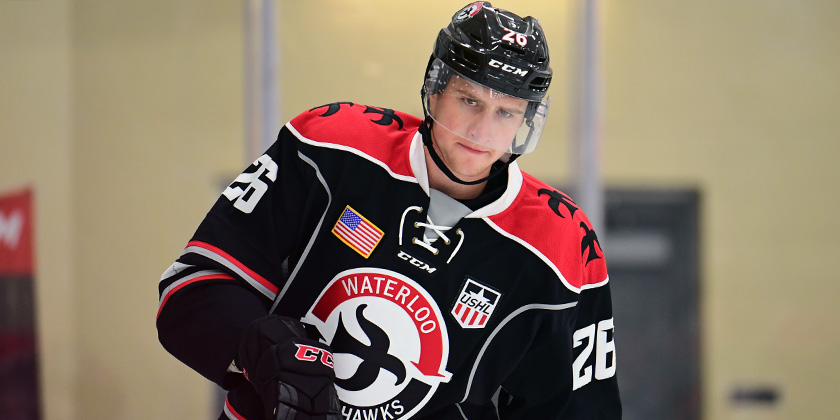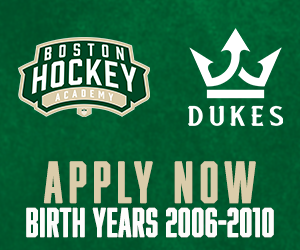by Jashvina Shah
Ever since he was little, Garrett Klee has been surrounded by hockey. His house was littered with mini sticks, he was always ducking in and out of rinks, and his earliest memory of hockey consisted of him, his dad and his brothers skating on a sheet of rented ice, precious moments tucked away between long road trips.
Garrett also went to work with his dad frequently. But as a little boy, he never quite understood what his dad did for a living, even when he spent time at the Capitals rink, hanging around with players like Jaromir Jagr, Adam Oates and Olie Kolzig.
“He was just like, ‘Oh my dad’s got a cool job, whatever, he plays hockey,’” Garrett’s dad, Ken, said. “He didn’t really understand playing in the NHL, what that meant.”
Ken was drafted by the Capitals and spent the first nine of his 13 NHL years playing for Washington, where Garrett was born and raised. When Garrett was five years old, the Klees moved to Toronto, where Ken played for the Maple Leafs in 2003-04. That’s when Garrett finally started to understand.
“He saw a different level of fan where there were people following us to school and they were like, ‘Dad everyone is looking at you, dad everyone knows who you are,’” Ken said. “And then it kind of hit him. OK, your dad has a pretty cool job and obviously other people are really huge fans of the game.”
But even before the Klees moved to Toronto, Garrett had already started subconsciously plotting his path in hockey, much similar to his dad’s.
“He just did it because it was what dad did, so he was like, well I want to do what dad does,” Ken said. “Most kids, they try to emulate their parents a little bit, and as he went through he realized, ‘I’m pretty good and I like it and it’s a great sport and I enjoy playing.’”
After leaving Washington, Ken also played for New Jersey, Colorado and Phoenix. Garrett was playing his youth hockey at the time, so his experience stretched across several different states.
“We were already moving around a bunch and I just thought that was kind of a normal thing, for you to move every year. I got to play with a lot of great kids. You get to see hockey outside of one state or you don’t play with the same group of kids that you play with your whole life,” Garrett said.
“I learned at an early age how small a hockey community is and that there’s great people in it. So I got to meet a lot of good players and great people along the way.”
He spent most of his time in Colorado, where he played for the Thunderbirds in the Tier 1 Elite League.
“They do a great job of pushing other players forward into playing juniors,” Garrett said. “They’ve done it for 11 years now and the biggest part of playing juniors would be that you’re acting more like a pro. It’s not youth hockey anymore. I think the T-Birds did a good job of taking that step and making a 16-year-old kid believe that this is something that you’re going to want to do for a long time, so you have to take it more seriously. And you come to the rink every day wanting to work hard and you’re surrounded by guys who all have the same goal, so it makes it a lot easier.”
After playing his U16 year with Colorado, Klee was drafted into the USHL by the Madison Capitols in the 13th round. He unexpectedly made the team and elected the USHL over spending his senior season at home.
“I think that the biggest part of my decision is that that’s what my dad did,” Garrett said. “When he left to go play juniors, he was a senior in high school, so I kind of made that my goal that I was going to follow in those footsteps. I decided that I want to play college hockey and that leaving my senior year was going to give me the best opportunity to do that.”
He joined the league as a 168-pound, 17-year-old rookie playing against 20-year-old skaters about to go to college. Adjusting to the size and speed was a challenge, but it helped him develop his hockey IQ. He finished his first season with three points over 41 games.
“He’s always been a very mature young person,” Ken said. “He’s got a brother who’s only 18 months younger, so he always took care of him and he’s always had the personality that he was a little grown up, even when he was a little kid.”
He then moved to Waterloo, where he spent the next two seasons. After scoring 10 goals and 19 points in his first season, he returned and captained the team last year, playing in 16 games and adding 18 points.
“One of the toughest challenges is just finding how you fit in every year into a team and that if you’re returning, like I was a returner for two years, you have to reestablish yourself and progress,” Garrett said. “You have to grow more or else you become kind of [replicable]. So first you have to make it and establish that you can do something extremely well, and as you progress through that, you have to add more things to it that you can also do really well and you keep growing as a player.”
While captaining the Black Hawks, Garrett also concluded his recruitment. This season he visited Michigan, Northern Michigan and Michigan Tech, adding to Maine and Providence, where he visited last year. The three teams from the Great Lakes State became the finalists, and Garrett chose Northern Michigan.
“I got a good feeling from there, and not that I had anything against the other two schools obviously, just when you kind of know you know,” Garrett said. “I just got a really good feeling from the staff there and all the boys there and the campus life was something I felt I could really see myself in. That was the ultimate reason.”
Despite not growing up an avid college hockey fan, Garrett pursued the path because Ken had also played college hockey and spoke well of his experience.
“His mom and I definitely pushed that, hey, at the end of the day you need an education,” Ken said. “Because even though your dad got to play in the NHL for 15 years or whatever it was, I have a lot more life to live, and being educated is definitely high in the importance scale of things you can do. You don’t know how your career’s going to go, but if you have an education always to fall back on, it’s a way to open up doors for the rest of your life.”
Garrett committed at age 20, becoming an anomaly in an age where college hockey recruiting targets players up to seven years younger.
“Kids are being recruited when they’re 14 years old, 15 years old, and with having no idea what they’re going to look like at 17, 18, 19, when maybe it really matters what kind of player they are,” Ken said. “And then, unfortunately, a lot of players are getting caught with committing to a school or a school committing to them and then you see they have buyer’s remorse, one way or another. I think it’s difficult. I think it’s a tough process on the kids. I wish they would move the age back on when you could actually recruit kids, but again I understand that there are coaches out there and they’re trying to get commitments from players as soon as they can to try to make their program as strong as possible.”
Ken’s recruiting process started nearly 30 years ago but was different from the norm even back then. He grew up in Kansas City without access to elite hockey programs, so he called a team in Toronto — the St. Michael’s Buzzers — when he heard they were holding tryouts. The team said he could attend if he paid his way there, so Ken footed the fare, showed up, made the team and was eventually recruited by Bowling Green. He spent three years with the Falcons and played in the World Junior Championship before leaving for the AHL, where he spent two years before being promoted. Ken now serves as an assistant coach with the Syracuse Crunch.
“When I went to Bowling Green there were players coming out that went to the NHL. Maybe it wasn’t as many, but there were still quite a few players doing it,” Ken said. “For me, it was a great experience because I was playing against bigger, stronger men, just like players are today. Players today are a couple years older. They’re going in later, but they’re more developed as athletes and as people. That’ll just benefit him. It benefits other players who come out of college and try to play pro because they’re not 20 years old. They’re 24 years old so they’ve already played some years against big strong men and they certainly know how to handle those kinds of things.”
While his parents, both former collegiate athletes, spoke of their past experiences and the importance of hard work and education, they never forced Garrett to pick one specific path, or to even pursue hockey at a high level. That was something he chose to do a long time ago, probably when he was just a child, skating with his dad on quiet rinks.
“When you play in the NHL, it’s a job and it’s a 24-hour-a-day job, it’s a seven-days-a-week job, so when you have moments where you can go out, enjoy and remember it’s a game, it’s a sport, it’s fun, remember the joy just from watching him get better, I think it helped me,” Ken said. “It helped me find balance in myself to help my game as well as it was just great to be able to watch him start by walking on skates, to be able to skate, to be able to move around, to be able to make plays. It’s just been great to watch him.”
Photo credit: Hickling Images





